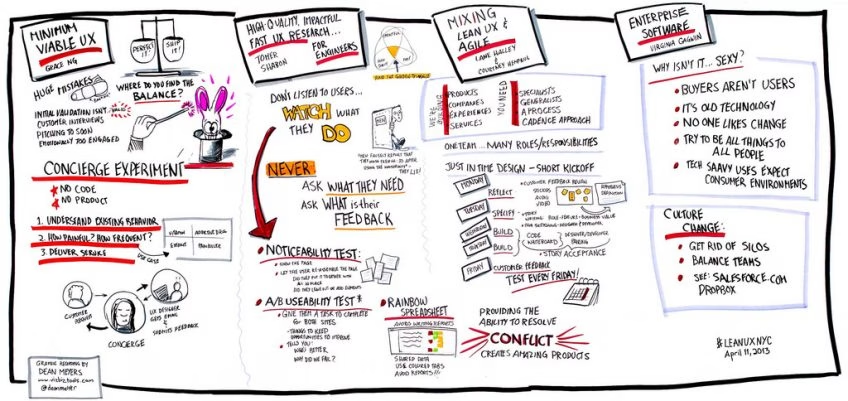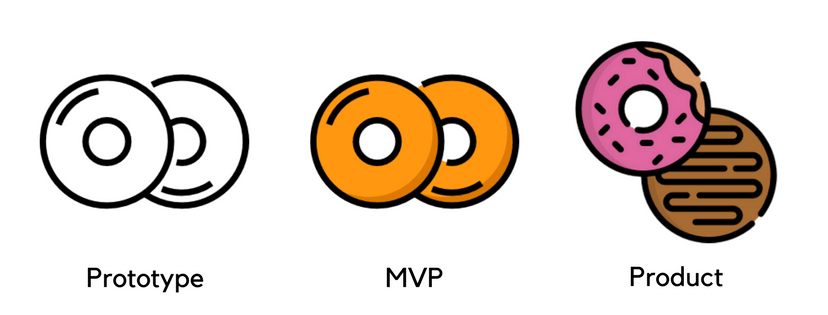
How to Create an MVP: 5 Steps & Tips
Want to know how to create an MVP?
You've come to the right place. In this article, I will provide 5 tips to create a sleek MVP (Minimum Viable Product).
In this article
- 5 Tips to Create a Sleek MVP
- Planning to create an MVP?
- Frequently Asked Questions on How to Create an MVP
Did you know that giants like Airbnb, Facebook, and Dropbox started their business by entering the market with just an MVP? Presenting a software product with basic functionality to your potential target audience is a good way to quickly receive customer feedback and see if they need your product.
5 Tips to Create a Sleek MVP
Consider the following tips for a successful MVP development process.
1. Decide the “why” of the MVP

As with any important project, foundational work is important while creating a great MVP. After all, you build a minimum viable product to validate a product idea early.

Get a complimentary discovery call and a free ballpark estimate for your project
Trusted by 100x of startups and companies like
You build an MVP with minimum features and as quickly as possible, to receive initial feedback from the market.
Therefore, you need clarity about your business idea itself, e.g., why will you build a product, and what you will build. You get this clarity in the following ways:
1a. Conduct market research
You might think that you have an excellent business idea, however, you need to find out if it’s viable. Market research is an essential tool for this since it provides you with the following:
- Industry information: You get to know the key industry trends, e.g., whether the industry you target is thriving.
- Consumer insights: This requires you to conduct a market survey. You need to study the market limits, the physical boundaries of the market, the spending characteristics of the population in the target geography, etc.
- Competitor insights: Market research offers you key information about your competitors.
1b. Research your business idea
This step uses the information you have gathered during market research, and it involves the following:
- Ascertain the potential of your business/product idea.
- Analyze the information you have obtained about customers and competitors.
- Think about the benefits to your company out of your business idea.
- Identify your potential collaborators, i.e., people and organizations that will benefit from your success even though they will not receive any direct payment from you.
- Decide your next course of action if you find that your business idea isn’t robust enough. E.g., you might decide to go back to the drawing board!
- On the other hand, if you find that you have a viable business/product idea, then move forward with the project.
2. Determine the “what” of your MVP:

You need to carefully determine what you will offer in your product, subsequently, what you will offer in the MVP. This 2nd tip should help you to define the scope of your MVP product development project.
You determine the product and MVP features in the following ways:
2a. Conduct a “Discovery session”
A discovery session is short, i.e., you should allocate 2-3 days for it. These are intense sessions, therefore, all stakeholders should effectively participate. Your discovery session should involve the following:
- Interviews with stakeholders, requirements gathering, etc.;
- Understanding the target users and their needs;
- Understanding the value from the users’ perspective and the metrics for determining the success of the product.
2b. Create a “Pain and gain” map to understand users’ pain points
While you might have listed various features for the product, not every one of them has the same impact. You can create a “Pain and gain” map to identify the most high-impact pain points of the target audience.
Subsequently, you can identify the proposed features that would address those pain points, and use a chart format for this.
2c. Prioritize the features for MVP
By now, you have a fair idea of the features that you should include in your product. You also have sufficient clarity over their impacts, therefore, you can now prioritize the features.
This will help you to decide which features you should include in the MVP, and which ones should be slotted for later iterations. You can use various tools and techniques for this, e.g.:
- Opportunity statements: You document quantifiable and qualitative values that each of the features will deliver. You will also consider user flow in the MVP development stage to ensure user satisfaction in the final product.
- Prioritization matrix: You can prioritize features by their impact and urgency. Include the features with high impact and urgency in the MVP and exclude the ones with low impact and urgency. If the impact is high and the urgency is low for a feature or vice versa, you can revisit it.
3. Plan to create an MVP successfully
You need to plan meticulously for making your MVP a success. This planning involves several considerations, e.g.:
3a. Avoid disruption to existing business
If you already have an established business, you should plan your minimum viable product development such that you don’t disrupt it. This involves the following:
1,200 top developers
us since 2016
- Plan for sufficient manpower so that you have enough people to support the existing business.
- Provision IT infrastructure and computing resources for the MVP so that there is no adverse impact on your current business.
- Design secure APIs for your existing business applications if you plan to use them in your MVP.
- Proactively mitigate information security risks and API security risks.
3b. Assemble a great team
You need to form a great team to create an MVP that delivers significant value to your customers. Such a team needs a project manager (PM), an IT architect, business analysts, web developers, testers, and DevOps engineers.
If you offer native mobile apps as part of the MVP, then you need mobile app developers for the Android and iOS platforms. Depending on your MVP requirements, you might need to hire developers with niche skills like Artificial Intelligence (AI), Augmented Reality (AR), etc.
Furthermore, it's better to hire developers who have experience in creating software solutions similar to the one you're planning. For example, if you're developing a SaaS project, you might want to partner with software developers who have a proven record of creating successful SaaS products.
You need a cohesive team since such teams are more likely to deliver complex projects successfully. Consider hiring an expert development team for MVP development, as I have explained in “Freelance app development team vs. field expert software development teams”.
3c. Opt for a managed cloud services platform
Your MVP app development will benefit from using a managed cloud services platform. Leading providers of managed cloud services like AWS or Microsoft Azure provision cloud infrastructure quickly for you, which helps you to expedite the project.
You can also use a multi-tenant public cloud if your MVP app security considerations permit that. This can reduce your costs, as explained in “Creating a minimum viable product for the enterprise: No trivial task”.
Managed cloud services offerings like “Platform as a Service” (PaaS) and “Mobile Backend as a Service” (MBaaS) can help to expedite your project noticeably. Take the example of AWS Elastic Beanstalk, the PaaS offering from AWS. It offers the following advantages:
- You can focus on developing your web app since Elastic Beanstalk manages the cloud infrastructure, networking, operating system, middleware, and runtime environment.
- It’s easy to integrate APIs when you use this PaaS platform, moreover, you can easily integrate database resources.
- Its robust DevOps and auto-scaling solutions are very helpful for MVP development.
If you are developing mobile apps as part of your MVP, then using AWS Amplify is a good idea. It’s the MBaaS offering from AWS, which offers the following advantages:
- You don’t need to spend time and resources to build and manage the mobile backend since Amplify manages the cloud infrastructure, persistent storage, etc.
- Securing your mobile app is easier when you use Amplify, moreover, you will find it easier to implement features like push notifications, user management, etc.
- You can scale your mobile app easily when you use Amplify.
3d. Choose the right architecture pattern
A successful MVP should scale well, moreover, you should find it easy to enhance and maintain it. You need to choose the right architecture pattern for this.
The choice of the right architecture pattern depends on the functional and non-functional requirements of your MVP.
E.g., if you can separate the various services you offer in the MVP and the services have no dependencies on each other, then you can choose the microservices architecture pattern. Read our guide “10 best practices for building a microservice architecture” for more insights.
4. Design a great “User Interface” (UI)
You can hardly overstate the importance of a user-friendly and effective UI in your MVP app. Design a UI that makes it easier for your users, and consult appropriate guidelines for this. You need to utilize the following resources:
- “User interface design guidelines: 10 rules of thumb”, for designing the UI for your web app;
- “Human Interface Guidelines”, which will guide you while designing the iOS app UI;
- Material design guidelines, for designing the Android app UI.
Going a step further, you should focus on the appropriate navigation menu pattern, color schemes, and icons for your mobile app UI. I recommend that you consult the following guides:
- “Mobile navigation menu examples”, for choosing the right menu pattern;
- “8 trends in mobile app color scheme”, which will help you to select the right color scheme for your mobile app;
- “How to design the perfect icon for your mobile app?”, for designing suitable icons for the mobile app UI.
5. Use the most suitable technology stack and tools to create an MVP app
You would need to choose a technology stack and development tools that suit the project requirements. However, I offer the following general recommendations:
5a. Programming languages and databases
Consider using the following programming languages and databases:
- You should use Node.js for developing the web app. This open-source runtime environment helps you to code scalable and performant web apps, moreover, a large collection of open-source tools improves your productivity. Read “10 great tools for Node.Js software development” for more insights.
- Kotlin is a robust choice for Android development since this open-source language helps to reduce the coding effort. You can create performant and scalable Android apps with it, moreover, it helps you to avoid common coding errors. On the other hand, Java continues to remain a popular choice for Android development. Our guide “Kotlin vs Java: which is the best choice?” will help you to choose between the two.
- You can use Swift for developing the iOS app. Apple champions this modern language, and it reduces the development effort. You can code scalable and performant iOS apps with it, moreover, Swift helps you to minimize common programming errors. Read our guide “How to migrate your Objective-C project to Swift?” for more insights.
- Python is a powerful language for AI/ML programming, and if your MVP involves AI/ML, then I recommend that you use it. I have explained its advantages in “Julia VS Python: can this new programming language unseat the king?”.
- I recommend PostgreSQL as the relational database and MongoDB as the NoSQL database. Both have powerful features that will help your MVP development project.
5b. Use GraphQL for API development
If you are designing and developing an API as part of the MVP, then I recommend that you use GraphQL, a modern query language for APIs. It has several advantages over RESTful APIs, e.g.:
- RESTful APIs return all data in an API endpoint, therefore, if you need more or less data, then you face the “under-fetching” and “over-fetching” problems, respectively. With GraphQL, you can specify the exact data you need.
- Programmers design RESTful APIs in line with their front-end views so that they can get all the data they need with one API call. However, if they modify the view, then they will need to change the API too. This slows down front-end iterations, however, the query language of GraphQL eliminates this challenge.
5c. Use the right tools to create an MVP
Depending on the technology you use in your MVP, you can expedite the project with the help of market-leading tools. A few examples are as follows:
- Vuforia for AR development;
- Amazon Sumerian for VR development;
- “Microsoft Azure AI Platform” for AI development.
You can read “How to create a minimum viable product for your enterprise company” for more examples.
Planning to create an MVP?
While this guide, platforms, tools, and frameworks can help you, keep in mind that developing minimum viable products can be complex. Consider engaging a reputed software development company for such projects.
Read our guide “How to find the best software development company?” to find such a development partner.
If still in search of an experienced software development partner, contact DevTeam.Space to outsource competent and vetted developers for our expert software developers community.
Write to us your MVP development specifications via this form and we will get back to you to discuss further how we can help you build your market-competitive MVP.
Frequently Asked Questions on How to Create an MVP
MVP stands for Minimum Viable Product. Minimum viable products are created in order to allow users to test and evaluate a basic version of a product. The user feedback is then used to build the best app possible. This development strategy allows developers to achieve user satisfaction in the future product with all the features.
A minimum viable product software is an excellent way to develop an idea into an application. They represent a low-risk and user-focused way to create applications as it emphasizes feedback from potential users from the very beginning.
You can find developers in the DevTeam.Space community. The platform has some of the top developers in the business. Their experience and skills represent all the main industries and tech stacks.


